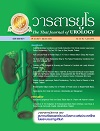Outcome of Laparoscopic and Robotic Assisted Laparoscopic Radical Prostatectomy in High-risk Localized Prostate Cancer
Keywords:
LRP, RALP, High risk localized prostate cancerAbstract
Background: The treatment for high risk localized prostate cancer patients still have controversial among radiotherapy (RT), androgen deprivation therapy (ADT) and radical prostatectomy (RP).Objectives: To study outcome of laparoscopic radical prostatectomy (LRP) and robotic assisted laparoscopic radical prostatectomy (RALP) in high risk localized prostate cancer patients.
Methods: In a retrospective descriptive analytic study from March 2005 to December 2009, 309 patients with prostate specific antigen (PSA) >20 ng/ml or Gleason score (GS) 8-10 points or Clinical T3a underwent LRP or RALP by 6 urologists. Preoperative, intraoperative and postoperative data were analyzed.
Results: The mean of age was 68.1+7.6 years old. The median of PSA was 26.27 (0.44-300) ng/ml. 48.9% of patients had GS 8-10 and 42.7% had clinical T3a. There were 61 patients (20.1%) receiving neoadjuvant ADT. 185 patients (59.8%) underwent LRP and 124 patients (40.2%) underwent RALP. The mean of operative time was 246.5+82.8 min with the median of blood loss 550 ml. (50-3,200 ml.). There was neither mortality nor converted operation to opened RP. 87 (28.3%) patients had morbidity after LRP and RALP with intraoperative complications; bleeding 17.9%, rectal injury 0.9% and nerve injury 0.3%, Postoperative complications; cardiovascular disease 10.7%, anastomotic leakage 10.4%, hematoma 3.2%, prolong lymph drainage 2.6%, bowel ileus 1.6%, pneumonia 0.9%, thromboembolism 0.3% and wound infection 0.3%. The mean of followup was 36.0+16.2 mo. There were late complications; anastomotic stricture 1.8% and one patient died from lung cancer. For pathological outcome, all patients had Adenocarcinoma with pGS7 47.7% and pGS8-10 47.7%.There were patients having pathological stage T3 62.3% and no lymph node metastasis 87.3%. 189 patients (61.7%) had positive margins. 5-yr Biochemical Progression-free survival (BPFS) was at 74.3%.
Conclusions: RALP is one of effective choice for treatment patients with high risk localized prostate cancer due to no mortality and minor complications.
Downloads
Published
2012-12-01
How to Cite
Im-oepsin, S., Nualyong, C., Leewansangtong, S., Taweemonkongsap, T., Amornvesukit, T., Chotikawanich, E., Soontrapa, S., Tantiwong, A., Sujijantararat, P., & Srinualnad, S. (2012). Outcome of Laparoscopic and Robotic Assisted Laparoscopic Radical Prostatectomy in High-risk Localized Prostate Cancer. Insight Urology, 33(2), 106–115. Retrieved from https://he02.tci-thaijo.org/index.php/TJU/article/view/63157
Issue
Section
Original article


